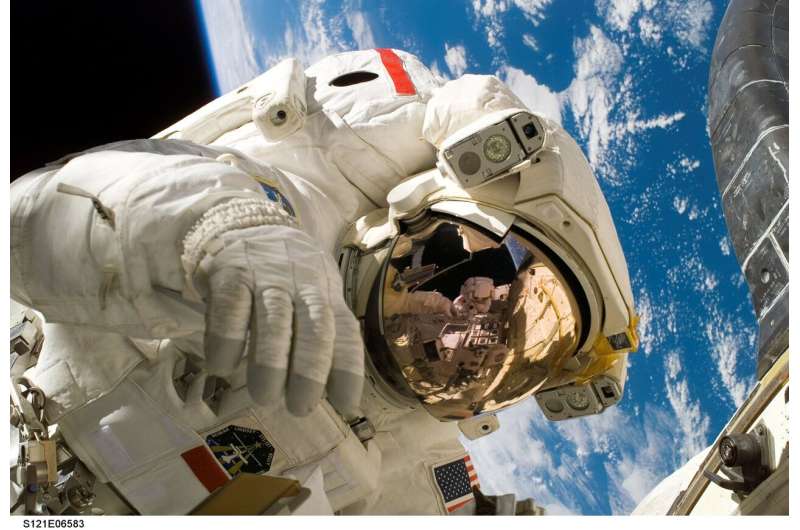This article has been reviewed according to Science X's editorial process and policies. Editors have highlighted the following attributes while ensuring the content's credibility:
fact-checked
peer-reviewed publication
trusted source
proofread
Wearable devices may prevent astronauts getting 'lost' in space

The sky is no longer the limit—but taking flight is dangerous. In leaving the Earth's surface, we lose many of the cues we need to orient ourselves, and that spatial disorientation can be deadly. Astronauts normally need intensive training to protect against it. But scientists have now found that wearable devices which vibrate to give orientation cues may boost the efficacy of this training significantly, making spaceflight slightly safer.
"Long-duration spaceflight will cause many physiological and psychological stressors, which will make astronauts very susceptible to spatial disorientation," said Dr. Vivekanand P. Vimal of Brandeis University in the United States, lead author of an article in Frontiers in Physiology on this topic. "When disoriented, an astronaut will no longer be able to rely on their own internal sensors, which they have depended on for their whole lives."
Personal space
The researchers used sensory deprivation and a multi-axis rotation device to test their vibrotactors in simulated spaceflight, so the senses participants would normally rely on were useless. Could the vibrotactors correct the misleading cues the participants would receive from their vestibular systems, and could participants be trained to trust them?
In total, 30 participants were recruited, of whom 10 received training to balance in the rotation device, 10 received the vibrotactors, and the remaining 10 received both. All participants were shown a video of the rotation device and told how it worked: moving like an inverted pendulum until it reached a crash boundary, unless it was stabilized by a person sitting in the device controlling it with a joystick.
Additional training, for the participants who received it, included tasks that taught participants to disengage from their vestibular sense and rely on the vibrotactors instead of their natural gravitational cues. These tasks involved searching for hidden non-upright balance points, which meant participants had to ignore their desire to align to upright and focus on the vibrotactors.
All participants were given a blindfold, earplugs, and white noise to listen to. Those with vibrotactors had four strapped to each arm, which would buzz when they moved away from the balance point. Each participant took part in 40 trials, aiming to keep the rotation device as close to the balance point as possible.
For half the trials, the rotation device operated on a vertical roll plane. This was considered an Earth analog because participants could use their natural gravitational cues for orientation. During the second half, which acted as a spaceflight analog, the rotation device operated on a horizontal roll plane where those gravitational cues could no longer help.
After each block of trials, participants were asked to rate how disoriented they felt and how much they trusted the vibrotactors. The scientists measured their success by looking at how often they crashed and how well they controlled their balance.
To infinity and beyond
All the groups were initially disoriented in the spaceflight analog. The scientists expected this, because participants could not rely on the natural gravitational cues that they usually use. Nearly all participants reported that they trusted the vibrotactors, but they also reported confusion from conflicts between their internal cues and the vibrotactors.
The participants wearing vibrotactors still performed better than those who only received training. The training-only group crashed more frequently, moved around the balance point more, and accidentally destabilized themselves more often. Receiving the training did help, though. As the trials continued, the group who received both training and vibrotactors performed best.
However, even with training, the participants didn't perform as well as they did in the Earth analog. They may have needed more time to integrate cues from the vibrotactors, or the buzzing from the vibrotactors may not have given a strong enough danger signal.
"A pilot's cognitive trust in this external device will most likely not be enough," said Vimal. "Instead, the trust has to be at a deeper—almost sub-cognitive—level. To achieve this, specialized training will be required."
If the sensors succeed in more extensive trials, the scientists said, the possible applications for spaceflight are many—from helping astronauts land safely on the surface of a planet, to supporting them as they move outside a vehicle in space.
More information: Vibrotactile Feedback as a Countermeasure for Spatial Disorientation, Frontiers in Physiology (2023). DOI: 10.3389/fphys.2023.1249962
Journal information: Frontiers in Physiology
Provided by Frontiers





















